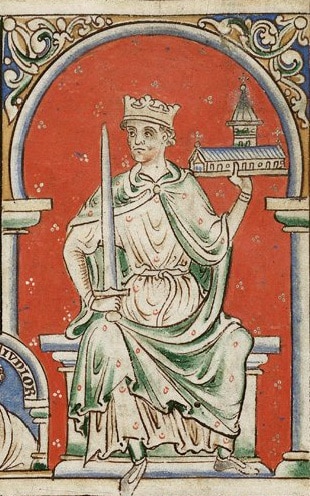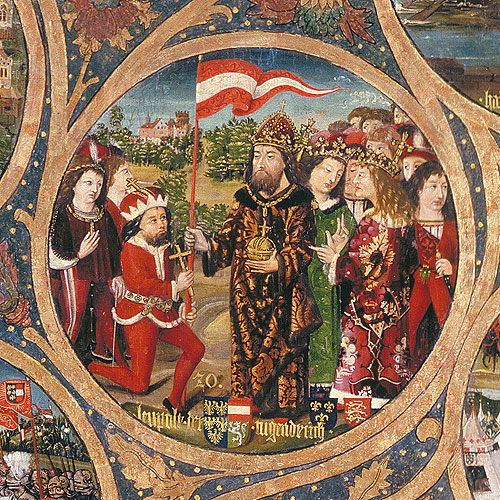
I am thrilled to be welcoming Olivia Longueville to the blog – she and J.C. Plummer have just released Robin Hood’s Widow, the second book in their Robin Hood Trilogy – a retelling of the Robin Hood story with an unusual and imaginative plot that is solidly grounded in 12th century history (it looks amazing, by the way!). The post is a wonderful story involving Richard the Lionheart that provides a backdrop to the book’s narrative….hope you enjoy!
***
Historians and history enthusiasts know the legends and tales about Richard the Lionheart, the third son of King Henry II and Queen Eleanor of Aquitaine. Perhaps one of the most fascinating stories of his reign is the account of his travels after leaving the Holy Land and his capture in Vienna. It is a tale that brings to mind the Odyssey of Odysseus. In Robin Hood’s Widow, the second installment in our Robin Hood Trilogy, readers follow in King Richard’s footsteps during this fateful journey.
Having made peace with Sultan Saladin, Richard ensured that Christian pilgrims would have access to Jerusalem for three years. Alerted by his mother that Prince John, his younger brother, was plotting against him, Richard set off from the Holy Land in October 1192, accompanied by his closest entourage. Following a series of harrowing sea voyages that took him as far west as Sicily, King Richard eventually made landfall on the northern coast of the Adriatic Sea, near the old Roman city of Aquileia.
In Sicily, Richard and his men had learned that there was no safe harbor for them in either Italy or the southern coast of France. With no other options, the monarch and his companions were compelled to take the land route through central Europe. They planned to seek help from Richard’s brother-in-law, Henry the Lion of Saxony. Pursued by local officials who were vassals of the Holy Roman Emperor Henry VI, yet another enemy of Richard, they could not remain in one place for long. To avoid recognition, they traveled fast, at the very limits of their endurance.
Finally, the King of England arrived in Erdberg (modern Landstraße district), on the outskirts of Vienna, with only one trusted knight (William de l’Etang), and a young interpreter. By that time, the monarch felt unwell; Richard was sweating, exhausted, and feverish. The Angevin ruler found shelter in a local inn and sent the boy to purchase food while William traveled to Saxony to secure help from Henry the Lion. There are different versions of how Richard was discovered, but we know that the boy’s presence in the market attracted unwanted attention.
The boy, whose name might have been Ioldan, spoke German with a peculiar accent because he was from an area far to the south of Vienna. However, it was his apparently arrogant demeanor that made him noticeable in the market. According to contemporary chronicles, the boy was holding himself “too courtly and too proudly.” To the astonishment of tradesmen, he possessed considerable sums of money, but he had to exchange his exotic Syrian coins for Viennese currency. The boy’s money and odd manners stirred suspicion among the locals, one of whom must have dispatched a report to Leopold V, Duke of Austria and of Styria.
Severe winter weather raged outside the inn where an ailing King Richard rested. On the 21st of December 1192, the Feast day of St Thomas the Apostle, the boy wore Richard’s ornate gloves with the royal insignia on his daily trip to the market for food. It’s possible that the monarch had kindly lent the gloves to him because of the wintry conditions. With suspicions of the boy already raised, the gloves seemed to be the final straw as Duke Leopold’s men seized the boy for questioning. At this point, this boy disappears from the pages of history; he was probably tortured by Leopold’s agents into revealing the secret of his master’s identity and location.

Duke Leopold must have been most pleased with the news, for he had a personal feud with the Crusader-King. In Acre, Leopold had been commander of the German forces, so he had wanted a share of the glory (and spoils) equal to those of King Richard I of England and King Philip II of France. Richard haughtily rejected his demands and removed Leopold’s banners from the walls of Acre. The enraged duke hastily departed for Austria.
The small inn of Erdberg was encircled by Leopold’s men. Most likely, when King Richard sensed danger, he attempted to escape. One legend has Richard, upon hearing the clamor of the arriving soldiers, dashing into the kitchen and pretending to be a cook turning the spit. Yet, it was too late—there were no avenues of escape left for the trapped king. Richard told his pursuers that he would only surrender personally to Duke Leopold. Upon the duke’s arrival, Richard exited the inn and, guarded by soldiers, audaciously strode towards Leopold.
It was a defining event in the lives of both men. A moment of complete triumph for Duke Leopold, who must have beheld his adversary with a blend of malice and glee. But an occasion of bitter humiliation for King Richard, the legendary hero of Christendom. With an air of innate regality, dignity, and poise about him, the English monarch relinquished his sword to Leopold and surrendered. Ironically, Richard was only 50 miles away from the safety of Saxony.

In Robin Hood’s Widow, Robin accompanies his liege lord from Acre, and he is there with Richard, William de l’Etang, and Ioldan in those fateful final days prior to the king’s capture.
In England, the news of King Richard’s capture was met with outrage and consternation. His arrest was considered appalling and ungodly. Many people demanded that Pope Celestine III excommunicate Duke Leopold and Emperor Henry for imprisoning a fellow Crusader. The first impulse of a bereft Eleanor must have been to travel to Germany in order to see her favorite son. Nevertheless, Eleanor pulled herself together and took the reins of government into her capable hands, knowing that her youngest son’s seditious alliance with King Philip might lead to a possible invasion of Normandy while she personally initiated negotiations with the emperor.
During the 13 months of Richard’s captivity, Eleanor of Aquitaine would play a crucial role in the affairs of her sons: raising Richard’s ransom, actively governing his lands, and tempering John’s ambitions as much as possible. The final installment of our trilogy, Robin Hood’s Return, will be set during this uncertain and perilous time as Robin and his beloved Marian uncover a deadly plot against both King Richard and Prince John.
Bibliography
- Boyle, David, Troubadour’s Song: The Capture, Imprisonment, and Ransom of Richard the Lionheart, Walker & Company, 2005
- Gillingham, John, Richard I, Yale University Press, 1999
- McLynn, Frank, Richard and John: Kings at War, Da Capo Press, 2007
- Turner, Ralph V. and Heiser, Richard R., The Reign of Richard the Lionheart: Ruler of the Angevin Empire, 1189-1199, Pearson Education Limited, 2000
***
If you loved the post, you can find out more about the story at the project’s website, www.angevinworld.com. You can also go check out Olivia’s own website or follow her Facebook page (her co-author, writer/historian J.C. Plummer, has a Facebook page too!) – or, even better, check out the book!
***
And of course, feel free to show my own books some love as well! The Path to Somerset is the latest in the Seymour Saga – have you read it yet? (Will you please review it?) Click on the photo to be taken to Amazon.Com:
(What? You haven’t read or reviewed Jane the Quene yet? Please do! Here are some easy links to Amazon.Com, Amazon.Co.UK and Amazon.Com.Au!)



[…] also published on the website of Janet Ambrosi Wertman: https://janetwertman.com/2020/05/15/the-lion-is-snared-guest-post-by-olivia-longueville/ […]